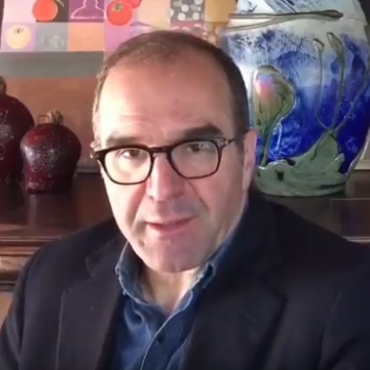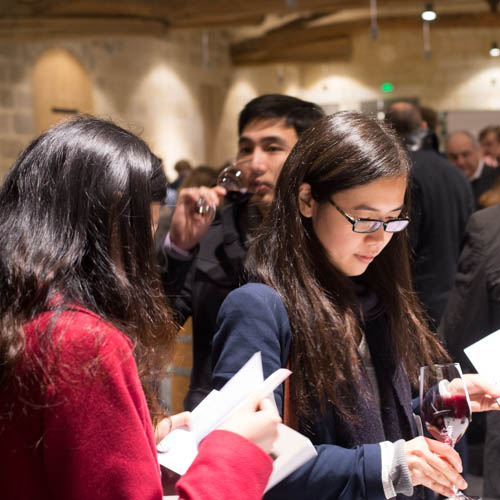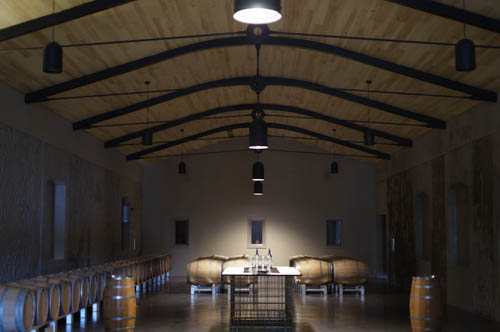by Wine Owners
Posted on 2018-04-04
Follow us on Twitter and Instagram next week as our team will be sharing their first impression and analysis on the new vintage live from le Bordelais.
Here's a taste of our week:
Monday
|
Tuesday
|
Wednesday
|
Thursday
|
Lafite
Mouton
Cos d’Estournel
Pontet Canet
Calon Segur
Montrose
Margaux
|
Nenin
VCC
Cheval Blanc
Château de Ferrand
Gazin
La Couspaude
Canon
Pavie
|
Haut Brion
Pape Clément
Malartic Lagravière
Smith Haut Laffite
Haut Bailly
Lafon-Rochet
Beychevelle
Siran
Lagrange
|
Le Pin
La Conseillante
Figeac
Eglise Clinet
Angelus
Latour
Palmer
Ulysse Cazabonne
Leoville Barton
|
by Wine Owners
Posted on 2017-05-23
Early afternoon 22nd May word spread that Lafite was out. A few calls were made. But where was the wine? Allocations were down 50% but with the promise of another allocation in a week’s time at a premium of between 30%-40%. No prices, no offers.
Then, more than one of the smaller négociants decided to pull the trigger on releasing the première tranche, but estimating the cost of the second tranche and pricing at the intersect of the two. Perhaps guessing they were unlikely to get any more and taking attractive profits on the first tranche.
In UK terms the averaged, intersect price is £480 a bottle, which puts the first release at around £384 a bottle whilst the second release could be in the range £540-£575.
That compares to the 2015 release price of £358 per bottle, which in turn leads us to the conclusion that in euro terms the first tranche release price is likely to have been more or less flat year on year. But of course, we can’t be sure.
The rest of the supply chain is sitting tight. The majority of Lafite offers won’t now reach your inbox for another week. The channels of distribution are showing admirable sense and fair play in averaging the two release prices and treating their customers with the egalité most deserve.
So how about the wine? Lafite 2016 is glorious: one of a handful of wines that stand imperiously; pinnacles in this truly great left bank vintage. Is it worth £480 a bottle? A difficult question to answer, but surprisingly, it does look like acceptable value in the context of current market prices of prior excellent or great vintages.
Below is our relative value analysis. Based on our estimations of what’s likely to happen in the next week, 2016 is showing a small advantage over prior vintages. If you consider that 2009 and 2010 are well off their lows, and that the absolute low of Lafite 2010 was £446 a bottle, it indicates that 2016 has very limited downside, and might well run up to around £600 a bottle over the next 3 years.
Once selling commission of 5% inclusive is taken into account and an adjustment for storage fees, your net proceeds would be £567, or a return of £87 a bottle: a return or discount to future market value (depending on your perspective) of 15%. Based on the above illustration an en primeur purchaser will be therefore looking at growth averaging 5% per annum.
It’s tight. There’ll be buyers. Notwithstanding, if the averaged price per bottle shakes out around £450-£460 many more collectors would swing behind it.
by Wine Owners
Posted on 2017-05-11
The tasting event in Westminster for the trade in early May provided an opportunity to re-taste a number of 2016 Bordeaux comparatively with their 2015 and 2014 equivalents.
The conclusions reinforce to a large extent the general impressions we formed in Bordeaux at the start of April, but the comparison also showed it’s not one size fits all.
Canon
Starting with the one wine tasted from the right bank, Canon 2016 is showing more aromatics than 2015, very silky, integrated tannins and is thicker-styled, with riper fruit. Canon 2015 showed greater intensity, with a stunningly pure mid-palate of ripe, sticky fruit, and a prolonged finish. Canon 2014 is more classically styled, with a cedar nose and liqueur-like mouth feel, this is lovely now and looks like much earlier drinking.
No doubt there are glorious wines from the Libournais in 2016, but both St Emillion and Pomerol do not conform to a vintage stereotype in these two vintages, and you will have preferences for individual wines from one or other year.
Smith Haut Lafitte
Jumping down to Pessac-Léognan, Smith Haut Lafitte (SML) 2016 is firm and properly dry, with crystalline fruit. Very intense and just on the right side of focus, with a very grippy, licorice finish. SML 2015 has a very energetic attack, sweet, refined tannins, a warm, fruity mid-palate and an aromatically spiced finish. SML 2014 was delicious but not in the same league as the other two vintages.
2015 was a stellar vintage in Pessac and Graves across the board. The same is not true of 2016 but SML showed (along with Haut Bailly, Chevalier and Carmes Haut Brion) that the best 16s are superlative and brilliantly architected for the long-term.
Rauzan Ségla
Rauzan Ségla 2016 is refined, with a liqueur-like mouth feel, and a hint of prunes. It’s less pure than Rauzan-Ségla 2015, with its fine nose, superbly energetic attack, refined mid palate and liquorice infused, fruit-driven finish. Rauzan-Ségla 2014 is dry, mid-weight, unforced and classic, with appealing grip, and a great, insistent finish.
Margaux was a star appellation of 2015, and this wine confirms how relatively disappointing the commune'’s wines are in 2016. They remain fine claret from a good vintage, but they miss out on the excitement of the ‘15s.
Pontet Canet
Our Pauillac representative of the comparative tasting stood out for its increasingly aromatic character, a factor that Justine Tesseron attributes to the growing influence that biodynamic farming is having on the fruit.
Pontet Canet 2015 was one of the most refined and silky examples of the appellation, yet today it just didn't cut it in the company of the glorious 2014 and deeply serious 2016. Pontet Canet 2016 displayed a fine nose, wonderfully textured fruit, a really firm mid-palate with bitter-edged fruit before sweetening into the long finish. Serious, long-haul stuff – and I suspect might become a legend 50 years hence. Pontet Canet 2014 is extremely aromatic, sweetly imbued with angelica flavouring, and with proper, grainy tannins on the finish.
Montrose
Montrose 2015 is delicious and aromatic: a fine showing for the vintage, yet seemed to lack a bit of structure. St Estephe in particular produced some of the best wines in a generation in 2016, and Montrose shows up that difference as does almost every wine from the appellation. Montrose 2016 is equally as expressive as 2015, but feels like a wine for the longer term, with more serious structure and vital freshness. What impresses here is the focus and elegance, which make this one of the stars of the vintage.
Picture: Wine Owners Ltd.
by Wine Owners
Posted on 2017-04-05

by Wine Owners
Posted on 2017-03-28
The potential of the 2016 Bordeaux en primeur assessed from a comparative examination of the weather conditions
There is a weather station located near the airport in Bordeaux which has been recording details of rainfall and temperature since 1911. It’s worth mentioning that rain in Bordeaux-Merignac does not mean rain in St.Emilion; nor does the absence of rain in Merignac on a particular day signify no rain in Margaux. But if the 2016 Bordeaux en primeur campaign is to find traction then some consideration of the weather is important.
THE RAIN
Looking at a Table of Cumulative Precipitation (below) which covers several of the greatest vintages of the last 2 centuries (with a couple extra thrown in to demonstrate the ‘exceptions which prove the rule’), one is immediately struck by one anomaly - the 1982 vintage (the others we know about).
It is a sine qua non of red wine grape production to have a sufficient period of dry weather in the summer to induce hydric stress in the vine so that the plant will cease growth and focus on maturing its fruit. It’s also a general rule that wet weather at harvest time is not conducive to healthy picking conditions and produces rot.
Table of Cumulative Precipitation
THE HEAT
It is widely accepted that warm weather (as opposed to canicular heat - remember that 2003 had 50 days of temperatures warmer than 30°) is another critical ingredient in the production of great wine (also interesting to see just how much cooler it was in 1982) - see the table below of Maximum Average Temperatures.
Maximum Average Temperatures
Clearly, the temperature progression during 2016 was unusual and extraordinary. Not shown, but also relevant, is a table constructed of average minimum temperatures: 2016 was about average, and slightly cooler than many other years in July; certainly not as warm as 2003.
ASSESSMENT OF BORDEAUX 2016 VINTAGE
Whilst the general weather picture for a vintage is a good prognostication of the quality of the wines not everyone will have been dealt the same cards. Terroirs are not the same. Not every estates’ ambitions are equivalent. Not every vigneron has the tools, techniques and vision to maximise the potential. Some producers will undoubtedly over-reach themselves. Comparing the general climatic conditions for 2016 with other remarkable vintages several features of the 2016 Bordeaux vintage stand out:
- First, 2016 had no phenomenological events of any significance eg frost.
- Second, the precipitation in the growing season and replenishment of the water table set it up for drier conditions later in the year. Of course, warmer humid weather at this time meant vigilance in case of mildew etc.
- Third, the uniformity of temperatures and the progression of average temperatures until August, without the heat spikes of 2003.
- Fourth, August was an unusually sunny month in 2016.
- Fifth: the dry, warm months of July and August were followed by a beautiful autumn.
On the face of it, the charts above, general as they are, demonstrate that 2016 was one of the most remarkable years that Bordeaux vineyards have ever experienced. One might, with some justification, call it a ‘benchmark’ year. Coupled with the advancement in oenology and the investment in First floors which have been undertaken in the last 30 years and if meteorology were the only factor in determining vintage quality (so ignoring viticultural practises, key husbandry decisions, winemaking approaches and trends, sharp temperature spikes masked by monthly averages) then 2016 could be one of the greatest, if not the greatest of Bordeaux vintages. However, the true quality of the vintage will only be demonstrated by the en primeur tastings which are about to commence.
Estates are surely crying (with happiness) over their wines and as for the rest of us, to paraphrase Goethe: “If you've never drunk wine while crying, you don’t know what life tastes like.”
Stay with Wine Owners as we taste our way through the Bordeaux appellations next week. Follow our tweets @WineOwners1. As ever we shall represent the voice of the wine lover and collector pointing out where there's value and where it makes no sense to buy early. Not forgetting the merits in back vintages that en primeur comparative evaluation often spotlights. We look forward to your company along the way.
Tables: compiled and coloured by Wine Owners from data by Infoclimat
by Wine Owners
Posted on 2016-06-10
There’s a clear division between 2015 En Primeur releases before Vinexpo Hong Hong and those that have been announced since. It begs the question, why?
It's not just that the bigger Chateaux are the ones releasing later. After all, many important names had released well beforehand.
The answer is what happened whilst the producers were in Hong Kong.
We understand that producers were taken aback by the demand they experienced this year at Vinexpo, and they boarded the flight home with bulging order books.
For every producer who wants to sell the new wines through En Primeur and recognises the importance of providing a future upside for buyers of non-physical stock, there are others who see a new opportunity within the changing global fine wine market.
Bernard Magrez was full of the joys of spring at Vinexpo Hong Kong, confirming he had sold out of his impressive Chateau Pape Clement in 40 minutes.
He was refreshing in his analysis, saying that he knew he’d left money on the table for the merchant and En Primeur buyer, which he saw as a positive for the property’s burgeoning reputation. Surely if you’re going to be part of En Primeur that’s the way to do it: body and soul.
Many others however have been eyeing life after En Primeur for some time, but have held back from backing one horse or another by the generally morose market conditions. With green shoots appearing over the last 12 months, few were in the mood to risk seeing them wither.
But what they experienced at Vinexpo may have shifted the balance further away from genuine, tangible broad-based support for En Primeur.
The Chateaux owners were surprised by the jump in orders experienced for their back vintages. There was a realisation that the wine market in China was coming back after 4 years of austerity and Party approbation.
The politics seem to be loosening up a touch, the consumer is spending again and contributing strongly to GDP growth, imports of luxury goods are steady (and proportionately performing better than exports).
Not that the Chinese buy En Primeur, there’s still almost no market there for it there, but with physical stocks in Bordeaux being soaked up by a sharp uptick in demand, it’s hardly surprising many producers are choosing to hold onto significantly more of the new vintage, so that they can serve the Asian market further down the line.

What a relief it must be to see all those accumulated bottles sell.
If it’s all heading towards producers being the stockholders and focusing on selling back vintages at premium prices, the one thing I’d say to them is, don't confuse the issue by using the En Primeur system as purely a promotional opportunity in the marketing calendar to get press and attention, if you don't care so much if any actually sells. It creates mixed messages.
I am super-impressed by what Palmer are doing in terms of developing sales channels worldwide, focusing on selling physical stock, staging stunning auctions through their negociant shareholder, creating a brand to rival the Firsts - but the En Primeur thing just muddies the water and undermines the brilliance of everything else.
If the recent Sotheby’s auction of Chateau Palmer in Hong Kong points the way to selling En Primeur by the barrel to high rollers with privileged access thrown in, I would surely go down that route as a producer too. The equivalent of £10,800 per 9 litres (12x75cl) before seller commission is simply amazing if you can get it.

“Chapeau”. I raise my hat to the Chateaux who go the full-on brand-building route and do it this well - but why risk the negative sentiment and comments that a perceptually very high En Primeur release price creates? There are simply too many foreseeable consequences: negative comments (mea culpa); anxious merchant emails to clients warning them off; negociants dropping prices during the course of the same day the release happens in a mildly desperate attempt not to be left with expensive stock that might/ will have to be written down; and static or lower secondary market prices that will make consumer buyers feel negative about the brand due to being under water ‘x’ years down the line.
With Asian appetite for Bordeaux on the rise once again, the moment may have arrived when more and more producers will respond to the shift in demand for primary market releases of back vintages by backing the new horse. It’s a complicated decision with a brew of old allegiances, dependent market structures, local friends, brand building, rising land values and a changing global market. Watch this space.

